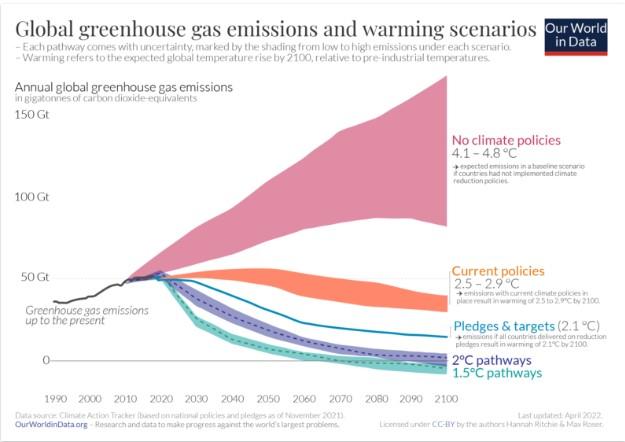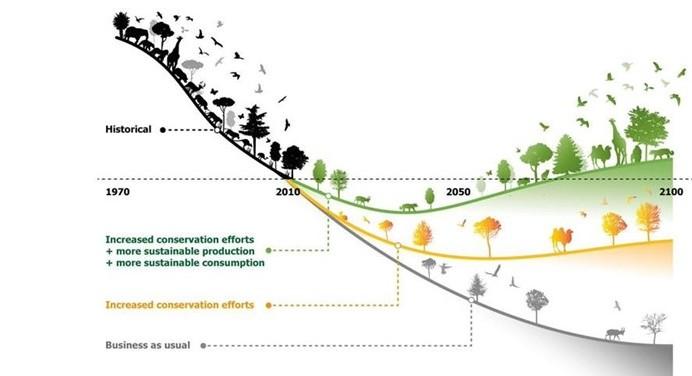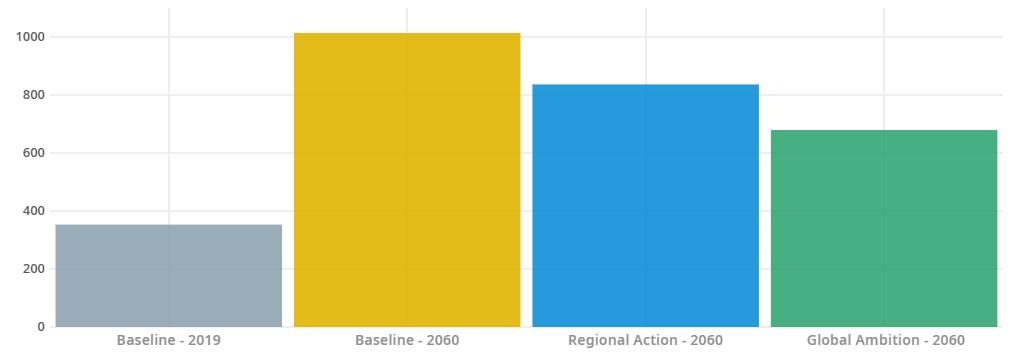Summary
It goes without saying that human-led activities have created certain problematic exponential trends, including greenhouse gas emissions, biodiversity loss, and global waste, that negatively impact the prospect of future sustainability as the organization of limited resources for their availability for future generations. According to multiple experts, modern society may fail to address these trends successfully, and sustainability remains questionable. However, specific graphs on data demonstrate positive dynamics – in other words, due to particular actions, people have an opportunity to succeed in addressing problematic exponential trends and moving to a more sustainable future.
Greenhouse Gas Emissions
Before the Paris Climate Agreement was made in 2014, greenhouse gas emissions were expected to cause a 4-degree-Celsius increase in the world’s temperature leading to catastrophic consequences. However, Figure 1 demonstrates how the curve has been bent due to modern policies dedicated to the use of clean energy and the reduction of greenhouse gas emissions for the prevention of climate change (Ritchie et al.). Thus, if these policies continue to be followed, they may lead to the 2,9-degree Celsius increase, and this is an improved result. At the same time, if policies are improved due to future technological advancements and all countries follow them, achieving emissions reductions, warming will be substantially limited.

Biodiversity Loss
The same tendency may be observed in relation to biodiversity loss as well. According to the World Wildlife Fund’s report, “populations of mammals, birds, amphibians, reptiles and fish have declined 68 percent on average” (Bending the Curve for Biodiversity). However, in order to bend this curve, people should pay particular attention to the increase of habitat restoration and protection, strategic landscape-level conservation and more sustainable production and consumption for the minimization of waste that negatively impacts biodiversity. Thus, if all countries follow policies dedicated to the protection of the environment and sustainability in human-led activities, biodiversity loss may be reduced as shown in Figure 2.

Global Waste
The same situation may be observed in relation to global waste as well. On the one hand, in the present day, excessive consumption and the technologies of production are associated with massive waste. On the other hand, a considerable number of countries have already realized the necessity of waste reduction and recycling. Thus, through the development of technologies and waste-related policies, the production and utilization of plastic waste may be decreased and increased, respectively. For instance, the reduction of plastic waste in the future due to regional and global actions is presented in the Figure 3.

Grand Transition
In general, the expected curves in greenhouse gas emissions, biodiversity loss, and global waste demonstrate that people may succeed in addressing disturbing trends. At the same time, regardless of the information presented above, it is obvious that actions should be taken in order to move to a more sustainable future in all spheres of life. At the same time, the Grand Transition requires the understanding of current degradation and its causes, the development of efficient strategies for its prevention, and changes in politics, communication, and public sector infrastructure for the implementation of these strategies. Meanwhile, while more and more countries realize the necessity of adequate policies for future sustainability, it is common efforts that may provide viable results.
Works Cited
“Bending the Curve for Biodiversity.” Credit Valley Conservation. Web.
OECD. “Global Plastics Outlook.” OECD. Web.
Ritchie, Hannah, et al. “CO₂ and Greenhouse Gas Emissions.” Our World in Data. Web.